Construction sector has been experiencing different new technologies and innovations and one of them is precast concrete panels. What are precast concrete panels? What are the frequently asked questions about precast concrete panels that you need answered? All your questions will be answered in this article.
What is precast concrete panels?
Precast concrete is a building and construction product manufactured using casting of concrete into a reusable mold or from which is then cured in a controlled environment, then transported to the construction venue and maneuvered into place. Some of the examples of precast concrete products include precast beams, wall panels, etc.
Types of precast concrete
Given below are different types of precast concrete products available.
Foundations – precast concrete products
Isolated footings
Isolated footings are usually used to hold and distribute concentrated loads brought by columns on superficial or shallow foundations. Isolated footings are made of either reinforced or non-reinforced material. These are usually utilized on smaller structures and residential buildings.

Related post: 4 Excellent House Designs in Kenya and Cost of Building
Pocket footings
These are usually used in both commercial and industrial buildings and they offer more strength to shallow foundations so as to carry and spread concentrated loads.

Related post: Why the Design and Build Concept is Ideal for Private Developers
Combined footings
The concrete footings are rectangular in shape and offer support to two or more columns often close to each to other such that their footings would overlap. They are more used in commercial and industrial buildings.

Precast piles
Precast piles are prefabricated piles manufactured from prestressed concrete and are driven into the ground with the help of diesel or hydraulic hammer. The piles are made of prestressed concrete and have fixed dimensions. They are normally used on conventional foundations and considered the cheapest method alongside the wooden piles.

Structural beams – precast concrete products
RCC beams
RCC beams are structural elements intended to carry transverse external loads that cause bending moment, shear forces, and in some cases torsion across their length.RCC beams generally have concrete resisting on the compression region and steel resisting applied loads on the tension region. It can be classified as per size into- rectangular, T-Beam, I-Beam, Circular Beam and L-Beam. It is used to support the building’s floors, roof, walls and cladding.

Prestressed beams –
FRP-prestressed beams are superior than those of steel-prestressed beams. It is very easy to mount with reduced on-site labor requirements and costs. It comes in a extensive range of depths to congregate exact building requirements It offers much-needed reinforcement for multi-story buildings and industrial applications.
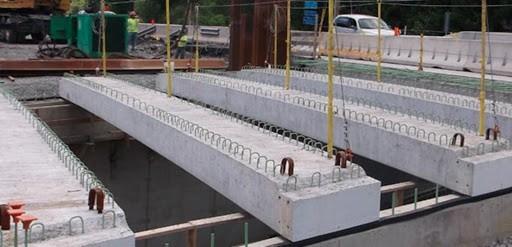
Shell beams
Shell beams are normally used with precast floor systems to streamline building programs and reduce on-site labour. Pre-stressed shell beam units, with the addition of a reinforcing cage and on-site concrete. Band depths of 290mm to 600mm and widths of 600mm up to 2400mm are possible. Reinforced Ultrashell beams can span up to 11m, with greater spans possible via the addition of Post Tensioning cables.

Slabs – precast concrete products
RCC slabs
This type of slabs are used for support conditions in buildings.RCC Slabs whose thickness ranges from 10 to 50 centimeters are most often used for the construction of floors and ceilings. Thin RCC slabs are also used for exterior paving purposes. In many domestic and industrial buildings a thick concrete slab, supported on foundations or directly on the subsoil, is used to construct the ground floor of a building. In high rises buildings and skyscrapers, thinner, precast concrete slabs are slung between the steel frames to form the floors and ceilings on each level.
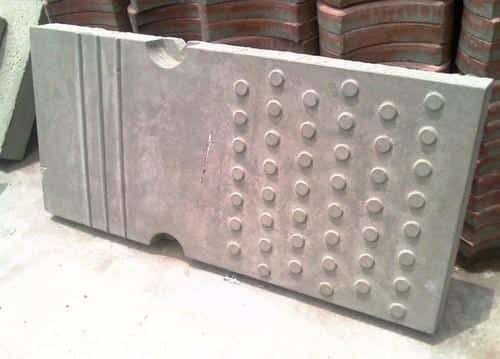
Prestressed hollow core slabs
A hollow core slab, also known as a voided slab, hollow core plank, or simply a concrete plank is a precast slab of prestressed concrete typically used in the construction of floors in multi-story apartment buildings. The production of these elements is achieved using our Extruder and Slipformer machines that cast in one phase along a production bed without the need for any formworks. Hollow core slabs are highly developed structural elements and are used all over the world due to their many advantages and diverse applications.
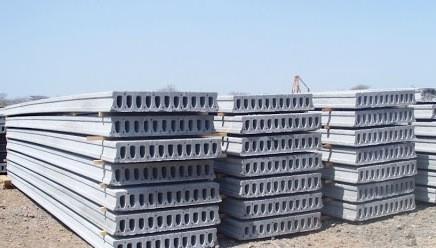
Prestressed solid slabs
The solid slab is a customized, loosely reinforced, full concrete slab that is used in residential and industrial construction. Mounting parts, such as electrical outlets, wiring, openings, etc. or even heating conduits can be previously installed in the solid slab in the precasting plant.

Double tee slabs
A double tee or double-T beam is a load-bearing structure that resembles two T-beams connected side by side. The strong bond of the flange (horizontal section) and the two webs (vertical members, also known as stems) creates a structure that is capable of withstanding high loads while having a long span. It can be applied in roofing, parking and bridges.

Waffle slabs
A waffle slab or two-way joist slab is a concrete slab made of reinforced concrete with concrete ribs running in two directions on its underside. The name waffle comes from the grid pattern created by the reinforcing ribs. Waffle slabs are preferred for spans greater than 40 feet (12 m), as they are much stronger than flat slabs, flat slabs with drop panels, two-way slabs, one-way slabs, and one-way joist slabs. Waffle slab can be used as both ceiling and floor slab. They are used in the areas where less number of columns are provided, i.e. it is used in the areas which have huge spans

Walls – precast concrete panels
Load bearing external walls
This wall is constructed to support the above slab or other building elements in a structure. These walls are generally 125 mm to 200 mm thick. The thickness depends on the load pattern.

Non-load-bearing walls
This wall holds up only itself. They carry only their weight and may be any one of the types discussed under load-bearing walls. This type of wall is used to close in a steel or concrete frame building. It is usually carried by supports, normally steel shelf angles on each floor. These walls are generally 50 mm to 100 mm thick.

Precast joist roof – precast concrete products
Precast joist roof is a building system in which precast reinforced cement concrete planks – rectangular slab elements – are placed on precast RCC joists. The roof gets completed with in-situ concrete poured over the haunches in planks and over the partially precast joists, thus ensuring monolithic action of individual precast elements.

Precast facade – precast concrete products
Precast sandwich panels enable the strict requirements for thermal insulation to be met. Concrete structures have great insulation qualities, keeping the building warm in cold weather and cool when it is hot, stabilizing the moisture and temperature inside. For the precast facade, a calculated age can be defined. One special feature of a precast façade is the panel joints

Glass Fiber Reinforced Concrete (GFRC) – precast concrete products
Glass fiber-reinforced concrete consists of high-strength, alkali-resistant glass fiber embedded in a concrete matrix. This is used especially for thin architectural cladding panels, but also for ornamental concrete such as domes, statues, planters, and fountains. Recently, decorative concrete artisans have discovered the benefits of GFRC for decorative panels (such as fireplace surrounds), concrete countertops, and artificial rock work.
Other elements – precast concrete products
Precast staircase
Precasting staircase produces better surface finishes, avoids the inherent problems of casting complicated inclined sections on-site and provides rapid access to successive floors. They are cost-effective. The staircase can be designed with landing slabs also.
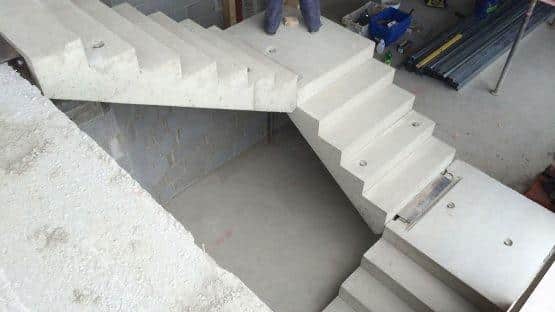
Precast Storm Water Drain
Precast concrete drains allow for speedier construction of Drains with minimum site work. These drains range in widths from 200 mm to 855 mm and these can be customized as per your needs. They are produced in strict factory controlled conditions that ensure high quality. These types of drains are also used in Residential Layout and Water Lines in industries.

Precast box culverts
These are embedded in and surrounded by soil. Culverts come in many different shapes and sizes, including round, elliptical, flat-bottomed, pear-shaped, and box. Box culverts are used for intakes and outtakes, holding tanks, steam tunnels, corridor links, road crossings, service tunnels and utility trenches. These culverts are used at the road crossings or when the vehicles need to run over them.

Precast UG Sumps
A sump is an underground (or partially underground) tank that is popular in India. It is usually used for large water tank storage and can be built cheaply using a precast method. These are useful as they are cast monolithically and much preferred by all sectors.

Precast Septic Tanks
Precast concrete septic tanks are strong, watertight, environmentally friendly, and ideal for any residential waste management system. These precast septic tanks are produced to meet your required dimensions and are easily installed at your home as well.
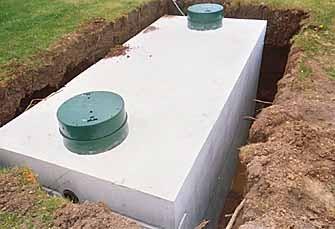
Precast toilets
This toilet is simple and ready to use immediately in few hours with all the multiple trade works involved in toilet markings such as waterproofing, plumbing, electrical, tiling, sanitary fittings, ventilators, doors, shower screens

How many types of precast concrete structures are there?
The precast concrete structures can be classified as per size into rectangular, T-beam, I-Beam, Circular Beam AND L-Beam. These precast concrete structures are used to support building floors, roof, walls and cladding.
Related post: 13 steps on how to find a good Construction Company in Kenya
What are the different types of precast concrete panels?
There are at least 12 types of concretes i.e reinforced concrete, stamped concrete, self-consolidating concrete, ready-mix concrete, glass fiber reinforced concrete, polymer concrete, ferro cement, fiber reinforced concrete, pervious concrete, foam concrete, shotcrete and bridge concrete.
What are the 2 most common precast concrete panels products?
The two common precast products used are the retaining walls and hard scaping products.
What are the different types of precast concrete columns?
There are three types of precast concrete columns namely edge columns-usually symmetrical in one direction, internal columns-usually symmetrical in all directions and corner columns-not symmetrical at all.





Types of precast slabs
There are three different types of concrete slabs namely; (1) slab on the ground which exist in two types i. e conventional slabs with deep excavated beams and waffle pod slabs, (2) suspended slab usually formed and poured in situ supported by formwork which are either removable of permanent reinforcement to the slab and (3) Precast slabs which are made in factory environment and transported to the site.
What are precast concrete slabs?
Precast concrete slabs are concrete slabs prepared, cast and cured off site and craned into place, usually in a controlled factory environment with the help of reusable moulds. Precast concrete slabs can be joined with other elements to form a complete structure.
Related post: Mansions VS Bungalows
What are the benefits of precast concrete panels?
Some of the benefits of precast concrete panels include; saving time, uniformity, high quality products, saving money, resistant to impact, corrosion, weathering and abrasion.
What is the purpose of precast concrete panels?
Precast concrete is used where the structural stability has to be maintained for long
Are you looking for a construction company in Kenya with experience in precast concrete panels? Talk to West Kenya Real Estate Ltd.
HOUSE PLANS FOR SALE AVAILABLE {architectural plan, structural plan, bill of quantities(BQ), Mechanical and Electrical plans}:
4bedroom Bungalow Home Design in Kenya
4BR Bungalow Designs with balcony in Kenya
4 Bedroom Flat roof Plan with Garage
5br Bungalow with Outdoor Dining
12 Units Gated Community House Plans in Kenya – 4 Blocks with 2 & 1 Bedroom Units
15 units Mixed Bedsitter and One Bedroom House Plans in Kenya
4BR Best selling Bungalow Design
3Bedroom Bungalow House Plans in Kenya
3-Storey Apartment House Plans Kenya
4-Floor Apartment House Plans Kenya
5-Bedroom Maisonette House Plans in Kenya
4BR Bungalow House Plans in Kenya
4Bedroom Bungalow Designs in Kenya
Affordable 4br Bungalow Designs in Kenya
Best Selling 4 BR Bungalow plans in Kenya
2-Bedroom Maisonette Flat Roof Design with Rooftop Garden
3Bedroom Bungalow Home Plan plus DSQ
5br Bungalow Plan with double volume wall
10 units bedsitter Apartment plan in Kenya
21 units 1br Apartment Plan in Kenya
5br Maisonette Home Plan with basement parking
4BR Miasonette Flat roof Plan in Kenya
Proposed 4Br Maisonette Flat Roof Design in Kenya
4BR Maisonette House Plans Kenya
4-Bedroom Maisonette Flat Roof with Car Garage – Modern Design for Comfortable Living
4BR Maisonette Design in Kenya Flat Roof with rooftop gazebo
4br Maisonette Flat Roof Design
4br Maisonette Home Designs in Kenya